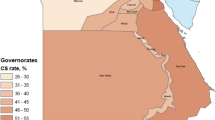Abstract
Doubling of C-section rates from year 2000 to 2015 globally was declared an eye-opener on October 13, 2018, in FIGO World Congress. Rapid increase in rates without clear evidence of concomitant decrease in maternal or neonatal morbidity or mortality raises significant concern that cesarean delivery is overused. This review addresses issues related to exponentially rising rates, reasons for it, and strategies to reduce. Previous cesarean delivery has main contribution to rising rates as per evidence from the literature search in last 5 years. Focus on optimizing indications of primary C-section resulted in making us rethink modifiable indications like labor dystocia, indeterminate fetal heart rate tracing, suspected fetal macrosomia, malposition, risk-adapted obstetrics, litigation fears, on demand cesarean in literate women and overuse of labor induction. Use of uniform classification system (Robson/WHO classification) with recommendations of WHO, FIGO and annual audits with cloud-based anonymous registry will streamline decisions for cesarean in nullipara and help to control the situation.
Similar content being viewed by others
References
Boema T, Ronsmans C, Melesse DY, et al. Global epidemiology of use of and disparities in caesarean sections. Lancet. 2018;392(10155):1341.
Gregory KD, Jackson S, Korst L, et al. Caesarean versus vaginal delivery: whose risks? Whose benefits? Am J Perinatol. 2012;29:7–18.
WHO statement on caesarean section rates. Geneva: World Health Organisation. 2015.
Clark SL, Belfort MA, Dildy GA, et al. Maternal death in the 21st century: causes, prevention, and relationship to caesarean delivery. Am J Obstet Gynecol. 2008;199:36e1–5.
Editorial. Stemming the global caesarean section epidemic. The Lancet. 2018;392(10155): 1279.
National Family Health Survey (NFHS-4) 2015-16. International Institute for Population Sciences, Mumbai, India.
Singh P, Hashmi G, Swain PK. High prevalence of cesarean section births in private sector health facilities- analysis of district level household survey-4 (DLHS-4) of India. BMC Public Health. 2018;18:613.
Desai G, Anand A, Modi D, et al. Rates, indications, and outcomes of caesarean section deliveries: A comparison of tribal and non-tribal women in Gujarat, India. PLoS ONE. 2017;12(12):e0189260. https://doi.org/10.1371/journal.pone.0189260.
Tanaka K, Mahomed K. The ten-group Robson classification: a single centre approach identifying strategies to optimise caesarean section rates. Obst Gynecol Int 2017, 5648938, 5 p. https://doi.org/10.1155/2017/5648938.
Torloni MR, Betran AP, Souza JP, et al. Classifications for Cesarean section: a systematic review. PLoS ONE. 2011;6(1):14566. https://doi.org/10.1371/journal.pone.0014566.
Zimmo MW, Laaine K, Hassan S, et al. Caesarean section in Palestine using the Robson Ten Group Classification System: a population-based birth cohort study. BMJ Open. 2018;1:2. https://doi.org/10.1136/bmjopen-2018-022875.
Nakamura-Pereira M, do Carmo Leal M, Esteves-Pereira AP, et al. Use of Robson classification to assess cesarean section rate in Brazil: the role of source of payment for childbirth. Reprod Health. 2016;13(3):128. https://doi.org/10.1186/s12978-016-0228-7.
Farine D, Shepherd D. Classification of Caesarean Sections in Canada: the modified Robson Criteria. A Comm Opin Obstet Gynaecol Can. 2012;34(10):976–9.
Betran AP, Vindevoghel N, Souza JP, et al. A systematic review of the Robson classification for Caesarean section: what works, doesn’t work and how to improve it. PLoS ONE. 2014;9(6):e97769. https://doi.org/10.1371/journal.pone.0097769.
Jacob KJ, Jayaprakash M, Hibina KP. TMC (Thrissur Medical College) modified Robson criteria for caesarean sections. Int J Reprod Contracept Obstet Gynecol. 2017;6:5038–43.
Voge JP, Betrán AP, Vindevoghel N, et al. Use of the Robson classification to assess caesarean section trends in 21 countries: a secondary analysis on behalf of the WHO Multi-Country Survey on Maternal and Newborn Health Research Network. Lancet. 2015;3(5):e260–70.
Catherine Y, Sponge MD. Prevention of the first cesarean delivery. Obstet Gynecol Clin North Am. 2015;42(2):377–80. https://doi.org/10.1016/j.ogc.2015.01.010.
Souza JP, Betran AP, Dumont A, et al. A global reference for caesarean section rates (:c-model) a multicountry cross-sectional study. BJOG. 2016;123:427–36.
Liu S, Liston RM, Joseph KS, et al. Maternal mortality and severe morbidity associated with low- risk planned caesarean delivery versus planned vaginal delivery at term. Maternal Health Study Group of the Canadian Perinatal Surveillance System. CMAJ. 2007;176:455–60.
Rajbhandary S, Shrivastava VR. Study of Indications and post-operative complications of primary caesarean section in tertiary care hospital in Nepal. Int J Reprod Contracept Obstet Gynecol. 2018;7(3):835–40.
Bhowmik J, Kyal A, Das I, et al. Pregnancy with previous caesarean section: an overview of adverse of fetomaternal sequelae. Int J Reprod Contracept Obstet Gynecol. 2018;7(5):1817–21.
Caughey AB, Cahill AG, Guise J-M, et al. Safe prevention of the primary caesarean delivery. Am J Obstet Gynecol. 2014;201(3):179–93.
Zhang J, Landy H, Branch W, et al. Contemporary patterns of spontaneous labor with normal neonatal outcomes. Obstet Gynecol. 2010;116:1281–7.
Spong CY, Berghella V, Wenstrom K, et al. Preventing the first Cesarean delivery; summary of a Joint Eunice Kennedy Shriver National Institute Of Child Health And Human Development, Society For Maternal- Fetal Medicine, and American College Of Obstetrician And Gynecologists Workshop. Obstet Gynecol. 2012;120:1181–93.
Nelson K, Sartwelle T, Rouse D. Electronic fetal monitoring, cerebral palsy, and caesareans: assumptions versus evidence. BMJ. 2016;355:16405.
Obstetric Care Consensus ACOG number 1, March 2014.
Wiklund I, Malata M, Cheung NF, Cadee F. Appropriate use of caesarean section globally requires a different approach. Lancet. 2018;392:1288–9.
Visser GHA, Ayres-de-Campos D, Barnea ER, et al. FIGO position paper: how to stop the caesarean section epidemic. Lancet. 2015;392(10155):1286–7. https://doi.org/10.1016/S0140-6736(18)32113-5.
Main EK, Chang S-C, et al. Safety assessment of a large-scale improvement collaborative to reduce nulliparous Cesarean delivery rates. Obstet Gynecol. 2019. https://doi.org/10.1097/AOG.0000000000003109.
Author information
Authors and Affiliations
Corresponding author
Ethics declarations
Conflict of interest
The authors declare that they have no conflict of interest.
Additional information
Publisher's Note
Springer Nature remains neutral with regard to jurisdictional claims in published maps and institutional affiliations.
Kalpana Mahadik, Professor, Department of Obstetrics and Gynaecology, at R. D. Gardi Medical College, Ujjain, India.
Rights and permissions
About this article
Cite this article
Mahadik, K. Rising Cesarean Rates: Are Primary Sections Overused?. J Obstet Gynecol India 69, 483–489 (2019). https://doi.org/10.1007/s13224-019-01246-y
Received:
Accepted:
Published:
Issue Date:
DOI: https://doi.org/10.1007/s13224-019-01246-y




